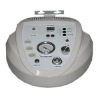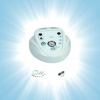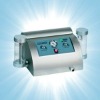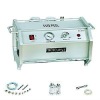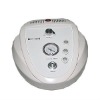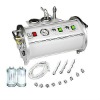- Vacuum Cavitation System[7]
- IPL Machine[10]
- RF Equipment[7]
- PDT Machine[3]
- Skin Scrubber[7]
- Derma Rolling System[7]
- Laser Beauty Equipment[10]
- Oxygen Jet[7]
- No-Needle Mesotherapy Device[7]
- Microdermabrasion Machine[7]
- Skin Analyzer[2]
- Other Beauty & Personal Care Products[3]
- Multi-Functional Beauty Equipment[2]
- Face & Body Mask[7]
- UV Lamp[7]
- Teeth Whitening[6]
- Dental Equipments[3]
- Emergency & Clinics Apparatus[5]
- General Assay & Diagnostic Apparatus[10]
- Other Shoes[1]
- Contact Person : Ms. Xie Candy
- Company Name : Beijing Huateng Zhongxun Tech Co., Ltd.
- Tel : 86-010-82958683
- Fax : 86-10-82958683
- Address : Beijing,Beijing,Room 627, 6th Floor, Tongyuan Building, No. 95, Qinghe St. 3, Haidian District
- Country/Region : China
3 in1 Electroporation Micro-Crystal Dermabrasion
1. Technical parameters.
Power Input: 110V/60Hz or 220V/50Hz
Max. Power: 30 W
Temperature range: 10°C-42°C
2. Accessories
Main unit 1 pc
Electroporation Treatment probe 2 pcs
3M Ultrasonic Treatment Probe 2 pcs
Anode plate 1 pc
Treatment cable 1 pc
Power Cord 1 Pc
Manual 1 pc
Fuse 2 pc
Paper Carton 1 pc
Packing Foam 1 set
3. Functions:
1. Electroporation
2. 3 M Ultrasonic
3. Diamond Dermabrasion
4. Electroporation Working Theory
Electroporation is a mechanical method used to introduce polar molecules into a host cell through the cell membrane. In this procedure, a large electric pulse temporarily disturbs the phospholipid bilayer, allowing molecules like DNA to pass into the cell.
5. Background
Many research techniques in molecular biology require a foreign gene or protein material to be inserted into a host cell. Since the phospholipid bilayer of the plasma membrane has a hydrophobic exterior and a hydrophobic interior (Fig. 1), any polar molecules, including DNA and protein, are unable to freely pass through the membrane.
Figure 1. Diagram of the Phospholipid Bilayer. This image shows the chemical components of the plasma membrane. The polar head groups face outward while the hydrophobic tail groups face inward and interact with one another to hold the membrane together. Polar molecules cannot pass through this membrane without external aid.
Many methods have been developed to surpass this barrier and allow the insertion of DNA and other molecules into the cells to be studied. One such method is electroporation.
The concept of electroporation capitalizes on the relatively weak nature of the phospholipid bilayer's hydrophobic/hydrophilic interactions and its ability to spontaneously reassemble after disturbance. Thus, a quick voltage shock may disrupt areas of the membrane temporarily, allowing polar molecules to pass, but then the membrane may reseal quickly and leave the cell intact.
Procedure
The host cells and the molecules to be inserted into these cells are suspended in solution. The electroporation apparatus is typically commercially produced and purchased, but the basic process inside such an apparatus may be represented in a schematic diagram
Figure 2. Diagram of the basic circuit setup of the electroporation apparatus. This diagram shows the basic electric circuit that provides the voltage for electroporation.
When the first switch is closed, the capacitor charges up and stores a high voltage. When the second switch is closed, this voltage discharges through the liquid of the cell suspension. Typically, 10,000-100,000 V/cm (varying with cell size) in a pulse lasting a few microseconds to a millisecond is necessary for electroporation. This electric pulse disturbs the phospholipid bilayer of the membrane and causes the formation of temporary aqueous pores. The electric potential across the membrane of the cell simultaneously rises by about 0.5-1.0 V so that charged molecules (such as DNA) are driven across the membrane through the pores in a manner similar to electrophoresis (Fig 3)
Figure 3. Graphic representation of plasmids containing a foreign DNA insert passing through temporary aqueous pores in the plasma membrane. The actual entry of DNA into the cell cannot be observed with a microscope, but this artist's rendering shows the basic concept of the formation of pores in the membrane through which DNA can pass.
As charged ions and molecules flow through the pores, the cell membrane discharges and the pores quickly close, and the phospholipid bilayer reassembles. The intended molecules should now be inside the cell for further use or study.
6. Advantages and Disadvantages of Electroporation
Several methods other than electroporation are used to transfer polar molecules like DNA into host cells. These other methods include microprecipitates, microinjection, liposomes, and biological vectors. (Melcher, 2000). Electroporation has both advantages and disadvantages compared to these methods.
3 in1 Electroporation Micro-Crystal Dermabrasion


